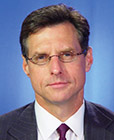Investing in change: 5 sectors to watch
Broad shifts in the economy, from inflation to global unrest, are creating opportunities that investors may want to consider now
“The planet could need to increase food production by about 50% in the next three decades in order to feed its growing population.”1
INVESTORS ARE WITNESSING “a great rotation,” says Chris Hyzy, Chief Investment Officer, Merrill and Bank of America Private Bank. “Some of the companies that experienced extraordinary returns in recent years are finding themselves most vulnerable to higher inflation and rising interest rates,” he notes. At the same time, other sectors — better positioned for potential growth amid today’s inflation, rising global tensions and the transition to renewable energies — are emerging as promising areas for investors to consider, he adds.
Specifically, “these five areas — fuels, aerospace and defense, agriculture, nuclear, and gold/metals/minerals — are poised to benefit in a new world of geopolitical risks with an intense focus on resources and hard assets,” says Lauren J. Sanfilippo, senior investment strategy analyst with the Chief Investment Office (CIO), Merrill and Bank of America Private Bank. “You could call them FAANG 2.0,” she adds. They represent a twist on the so-called FAANG stocks, a popular acronym coined back in 2013 for five of the world’s largest tech companies. “But instead of specific stocks, we’re focusing on several broader sectors.”
“We believe these sectors may offer future value as the economic rotation continues,” says Joseph P. Quinlan, head of CIO Market Strategy, Chief Investment Office, Merrill and Bank of America Private Bank.
Why they’re poised for potential growth
F – Fuels. The energy sector has declined as a market force in recent decades, representing just 4.5% of the S&P 500’s total market capitalization today, compared with 13% in 1990, Sanfilippo notes. Yet that very decline leaves the sector primed for growth at a time when the war in Ukraine has redrawn supply chains and countries emerging from the global pandemic need energy to power their economies. “A combination of geopolitical tensions, constrained supplies, strong demand and underinvestment will likely keep energy prices elevated over the medium term,” Sanfilippo says.
A – Aerospace and defense. With a war raging not far from their borders, European countries are re-arming. “Germany, for example, has pledged twice its annual defense budget,” Sanfilippo notes. “At a minimum, NATO member countries have pledged to contribute more than 2% of gross domestic product to the alliance’s defense by 2024.” Asian countries, too, are stepping up defense spending, and the upswing in spending includes not just weaponry but cyber security. Defense spending hit a record $2.24 trillion last year, with heightened spending likely to continue, she says.
A – Agriculture. Even without today’s turbulent forces, agriculture would be a key sector to watch. “The planet could need to increase food production by about 50% in the next three decades in order to feed its growing population,”1 says Quinlan. Moreover, agriculture as an investment sector may offer some protection from inflation. “Equipment shortages, higher input costs, climate challenges and burgeoning demand from the emerging-markets middle class all suggest more upside earnings potential for the global agricultural complex,” he adds.
“A typical electric vehicle requires six times the mineral inputs of a conventional car, according to the International Energy Agency.”4
N – Nuclear and renewable energy. Use of renewable energies such as solar and wind rose during the depths of the pandemic in 2020, even as demand for other energy sources declined. “Long-term contracts, ongoing installation of plants and priority access to the grid are among the reasons renewables should continue to grow,”2 Quinlan notes, adding that “in our opinion, nuclear energy will play a significant role in a clean-energy future. Nuclear has the highest capacity factor of any energy source, producing reliable, carbon-free power more than 92% of the time. That’s twice as reliable as coal or natural-gas plants and almost three times more than wind and solar plants.”3
G – Gold and minerals. This sector is increasingly attractive for a couple of reasons, Sanfilippo notes. First, gold is widely seen as a “safe haven” from inflation and geopolitical unrest. Second, minerals are essential to the transition to cleaner energy, particularly the batteries that power electric vehicles (EVs). “A typical EV requires six times the mineral inputs of a conventional car, according to the International Energy Agency,” Sanfilippo says. The need for lithium, for example, could increase by 40 times over current demand.4 Real assets, she adds, are in a longer-term bull cycle and will likely go through periods of high volatility, much as we’re seeing now.
What investors can consider
To capture the potential of some of these areas, investors might consider stocks related to defense and cyber security, as well as traditional and renewable energies and food production, Quinlan notes. Commodities may be worth considering as well, since they traditionally offer protection from inflation, and because they will be central to meeting demand for everything from food to minerals used in EV batteries.
Yet while investors should be aware of and plan for these economic shifts, the emergence of potential FAANG 2.0 opportunities doesn’t mean abandoning other investments in your portfolio. Any new investments should be made within the context of your long-term financial goals, Hyzy cautions. “If a strategic asset allocation plan is the heart of investing, diversification is the circulatory system, and long-term and goals-based thinking is the brain.” Keeping those qualities in mind may be the best way to pursue opportunities without making precipitous decisions.
A private wealth advisor can help you get started.
1 Nature Food, “A meta-analysis of projected global food demand and population at risk of hunger for the period 2010-2050,” July 2021.
2 IEA (International Energy Agency), “Renewables 2022,” December 2022.
3 The U.S. Energy Information Administration, March 7, 2022.
4 IEA (International Energy Agency), “The Role of Critical Minerals in Clean Energy Transitions,” updated March 2022.
Important Disclosures
Opinions are as of 06/01/2023 and are subject to change.
Investing involves risk including possible loss of principal. Past performance is no guarantee of future results.
This information should not be construed as investment advice and is subject to change. It is provided for informational purposes only and is not intended to be either a specific offer by Bank of America, Merrill or any affiliate to sell or provide, or a specific invitation for a consumer to apply for, any particular retail financial product or service that may be available.
The Chief Investment Office (CIO) provides thought leadership on wealth management, investment strategy and global markets; portfolio management solutions; due diligence; and solutions oversight and data analytics. CIO viewpoints are developed for Bank of America Private Bank, a division of Bank of America, N.A., (“Bank of America”) and Merrill Lynch, Pierce, Fenner & Smith Incorporated (“MLPF&S” or “Merrill”), a registered broker-dealer, registered investment adviser and a wholly owned subsidiary of Bank of America Corporation (“BofA Corp.”).
Investments have varying degrees of risk. Some of the risks involved with equity securities include the possibility that the value of the stocks may fluctuate in response to events specific to the companies or markets, as well as economic, political or social events in the U.S. or abroad. Investments in a certain industry or sector may pose additional risk due to lack of diversification and sector concentration.
There are special risks associated with an investment in commodities, including market price fluctuations, regulatory changes, interest rate changes, credit risk, economic changes and the impact of adverse political or financial factors.

